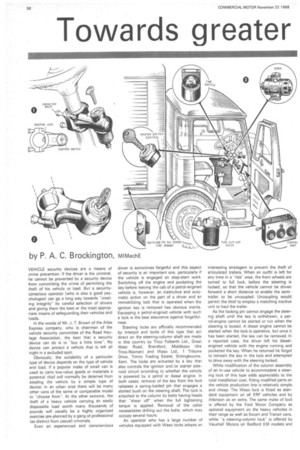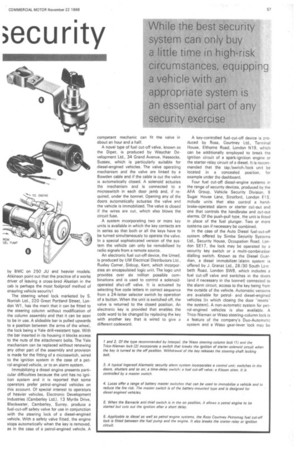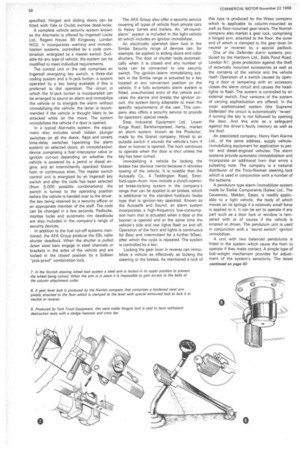Towards greater
Page 58

Page 59

Page 60

If you've noticed an error in this article please click here to report it so we can fix it.
;ecurity
VEHICLE security devices are a means of crime prevention. If the driver is the criminal, he cannot be prevented by a security device from committing the crime of permitting the theft of his vehicle or load. But a securityconscious operator who is also a good psychologist) can go a long way towards ''creating integrity" by careful selection of drivers and giving them the best or the most appropriate means of safeguarding their vehicles and loads.
In the words of Mr. J. T. Brown of the Atlas Express company, who is chairman of the vehicle security committee of the Road Haulage Association, the best that a security device can do is to "buy a little time". No device can protect a vehicle that is left all night in a secluded spot.
Obviously, the suitability of a particular type of device depends on the type of vehicle and load. If a popular make of small van is used to carry low-value goods or materials a potential thief will normally be deterred from stealing the vehicle by a simple type of device: in an urban area there will be many other vans of the same or comparable model to -choose from". At the other extreme, the theft of a heavy vehicle carrying an easily disposable load worth many thousands of pounds will usually be a highly organized exercise pre-planned by a gang of professional (as distinct from casual) criminals.
Even an experienced and conscientious driver is sometimes forgetful and this aspect of security is an important one, particularly if the vehicle is engaged on stop-start work. Switching off the engine and pocketing the key before leaving the cab of a petrol-engined vehicle is, however, an instinctive and automatic action on the part of a driver and an immobilizing lock that is operated when the ignition key is removed has obvious merits. Equipping a petrol-engined vehicle with such a lock is the best assurance against forgetfulness.
Steering locks are officially recommended by Interpol and locks of this type that act direct on the steering-column shaft are made in this country by Trico Folberth Ltd., Great West Road, Brentford, Middlesex (the Trico-Nieman) and Waso Ltd., 1 Tribune Drive, Trinity Trading Estate, Sittingbourne. Kent. The locks are actuated by a key that also controls the ignition and /or starter solenoid circuit according to whether the vehicle is powered by a petrol or diesel engine. In both cases, removal of the key from the lock releases a spring-loaded pin that engages a slotted bush on the steering shaft. The lock is attached to the column by bolts having heads that "shear off" when the full tightening torque is applied. Removal of the collar necessitates drilling out the bolts, which may occupy several hours.
An operator who has a large number of vehicles equipped with Waso locks adopts an interesting stratagem to prevent the theft of articulated trailers. When an outfit is left for any time in a "risk" area, the front wheels are turned to full lock, before the steering is locked, so that the vehicle cannot be driven forward a short distance to enable the semitrailer to be uncoupled. Uncoupling would permit the thief to employ a matching tractive unit to haul the trailer.
As the locking pin cannot engage the steering shaft until the key is withdrawn, a petrol-engine cannot be started or run when the steering is locked. A diesel engine cannot be started when the lock is operative, but once it has been started, the key can be removed. In a reported case, the driver left his dieselengined vehicle with the engine running and pocketed the key. When he returned he forgot to reinsert the key in the lock and attempted to drive away with the steering locked.
While modification of the column assembly of an in-use vehicle to accommodate a steering lock of this type adds appreciably to the total installation cost, fitting modified parts on the vehicle production line is relatively simple and cheap. The Waso lock is fitted as standard equipment on all ERF vehicles and by Atkinson as an extra. The same make of lock is offered by the Ford Motor Company as optional equipment on the heavy vehicles in their range as well as Escort and Transit vans, while "a steering-column lock" is offered by Vauxhall Motors.on Bedford KM models and by BMC on 250 JU and heavier models. Atkinson point out that the practice of a works driver of leaving a cross-bred Alsatian in the cab is perhaps the most foolproof method of ensuring vehicle security!
The Steering wheel lock marketed by S. Norrish Ltd., 220 Great Portland Street, London WI, has the merit that it can be fitted to the steering column without modification of the column assembly and that it can be seen to be in use. A slideable bar is pulled upwards to a position between the arms of the vvheeI, the lock being a Yale drill-resistant type, With the bar inserted in its housing it blocks access to the nuts of the attachment bolts. The Yale mechanism can be replaced without renewing any other part of the assembly and provision is made for the fitting of a microswitch, wired to the ignition system in the case of a petrol-engined vehicle, or to an alarm system.
Immobilizing a diesel engine presents particular difficulties because the unit has no ignition system and it is reported that some operators prefer petrol-engined vehicles on this account. Of special interest to operators of heavier vehicles, Electronic Development Industries (Camberley Ltd.), 13 Myrtle Drive, Blackwater, Camberley, Surrey, produce a fuel-cut-off safety valve for use in conjunction with the steering lock of a diesel-engined vehicle. With a safety valve fitted, the engine stops automatically when the key is removed, as in the case of a petrol-engined vehicle. A competent mechanic can fit the valve in about an hour and a half.
A novel type of fuel cut-off valve, known as the Dipet, is produced by Waychar Development Ltd., 34 Grand Avenue, Hassocks, Sussex, which is particularly suitable for diesel-engined vehicles. The valve operating mechanism and the valve are linked by a Bowden cable and if the cable is cut the valve is automatically closed. A solenoid actuates the mechanism and is connected to a microswitch in each door jamb and, if required, under the bonnet. Opening any of the doors automatically actuates the valve and the vehicle is immobilized. The valve is closed if the wires are cut, which also blows the circuit fuse.
A system incorporating two or more key units is available in which the key contacts are in series so that both or all the keys have to be turned simultaneously to operate the valve. In a special sophisticated version of the system the vehicle can only be remobilized by radio signals from a remote source.
An electronic fuel cut-off device, the Urneri, is produced by UM Electrical Distributors Ltd., Ruxley Corner, Sidcup, Kent, which incorporates an encapsulated logic unit. The logic unit provides over six million possible combinations and is used to control a solenoidoperated shut-off valve. It is actuated by selecting five code letters in correct sequence from a 24-letter selector switch by operation of a button. When the unit is switched off, the valve is returned to the closed position, An electronic key is provided that enables the code word to be changed by replacing the key with another key that is wired to give a different codeword. A key-controlled fuel-cut-off device is produced by Ross, Courtney Ltd., Terminal House, Elthorne Road, London N19, vvhIch can be additionally employed to break the ignition circuit of a spark-ignition engine or the starter-relay circuit of a diesel. It is recommended that the tap/switch /lock unit be located in a concealed position, for example under the dashboard.
Four fuel cut-off diesel-engine systems in the range of security devices, produced by the AFA Group, Vehicle Security Division, 9 Sugar House Lane, Stratford, London E1 5, include units that also control a handbrake-operated alarm or starter cut-out and one that controls the handbrake and cut-out alarms. Of the push-pull type, the unit is fitted in place of the fuel plunger. Two or more systems can if necessary be combined.
In the case of the Auto Diesel fuel-cut-off system offered by Simba Security Systems Ltd., Security House, Occupation Road, London SE17, the lock may be operated by a security key switch or a multi-combination dialling switch. Known as the Diesel Guardian, a diesel immobilizer /alarm system is offered by J. Granat Ltd., 28/30 South Lam. beth Road, London SW8, which includes a fuel cut-off valve and switches in the doors land if necessary in the bonnet) connected to the alarm circuit, access to the key being from the outside of the vehicle. Automatic versions are available for petroland diesel-engined vehicles (in which closing the door "resets" the system). A non-automatic system for petrol-engined vehicles is also available. A Trico-Nieman or Waso steering-column lock is a feature of the company's Duo-Automatic system and a Waso gear-lever lock may be
specified. Hinged and sliding doors can be fitted with Yale or Chubb mortise dead-locks.
A complete vehicle security system known as the Alarmatic is offered by Ingersoll Locks Ltd., Regent House, 89 Kingsway, London WC2. It incorporates warning and immobilization systems, controlled by a code combination, energized by a master switch. Suitable for any type of vehicle, the system can be modified to meet individual requirements.
The control unit in the cab comprises an Ingersoll energizing key switch, a three-dial coding system and a hi-jack button, a system operated by a key being available if this is preferred to dial operation. The circuit in which the hi-jack button is incorporated can be arranged to sound an alarm and immobilize the vehicle or to energize the alarm without immobilizing the vehicle; the latter is recommended if the vehicle is thought likely to be attacked while on the move. The system immobilizes the vehicle if a door is opened.
In a typical Alarmatic system, the equipment also includes small hidden plunger switches on all the doors, flaps and covers. time-delay switches (operating the alarm system) on selected doors, an immobilization device comprising a fuel interceptor valve or ignition cut-out depending on whether the vehicle is powered by a petrol or diesel engine, and an intermittently operated Klaxon horn or continuous siren. The master switch control unit is energized by an Ingersoll key switch and after the code has been selected (from 5,000 possible combinations) the switch is turned to the operating position before the vehicle is handed over to the driver, the key being retained by a security officer or an appropriate member of the staff. The code can be changed in a few seconds. Padlocks, mortise locks and automatic rim deadlocks are also included in the company's range of security devices.
In addition to the fuel cut-off systems mentioned, the AFA Group produce the EBL roller shutter deadlock. When the shutter is pulled down steel bars engage in steel channels or brackets in the sides of the vehicle and are locked in the closed position by a Sidleen "pick-proof" combination lock. The AFA Group also offer a security service covering all types of vehicle from private cars to heavy lorries and trailers. An "all-roundalarm" system is included in the light-vehicle kit which includes an ignition imrnobilizer.
An electrically operated slam lock in the Simba Security range of devices can, for example, be applied to sliding doors and roller shutters. The door or shutter locks automatically when it is closed and any number of locks can be connected to one security switch. The ignition /alarm immobilizing system in the Simba range is actuated by a key located at any convenient position on the vehicle, If a fully automatic alarm system is fitted, unauthorized entry of the vehicle activates the alarms and breaks the ignition circuit, the system being adaptable to meet the specific requirements of the user. This company also offers a security service to provide for operators' special needs.
Step Industrial Equipment Ltd., Lower Kings Road, Berkhampstead, Herts., market an alarm system, known as the Protector, made by the Granat company. Wired to an outside switch it sounds the vehicle's horn if door or bonnet is opened. The horn continues to operate when the door is shut unless the key has been turned.
Immobilizing a vehicle by locking the brakes has obvious merits because it obviates towing of the vehicle. It is notable that the Autosafe Co., 4 Teddington Road, Stratford-upon-Avon, now include a clutch-operated brake-locking system in the company's range that can be applied to air brakes, which is additional to the standard hydraulic brake type that is ignition-key operated. Known as the Autosafe and Sound, an alarm system incorporates a high-frequency low-consumption horn that is actuated when a door or the bonnet is opened and at the same time the vehicle's side and rear lights flash on and off. Operation of the horn and lights is continuous for 8sec and intermittent for a further 50sec, after which the cycle is repeated. The system is controlled by a key.
Locking the gear lever in reverse can immobilize a vehicle as effectively as locking the steering or the brakes. As mentioned a lock of this type is produced by the Waso company which is applicable to column-mounted as well as floor-mounted gear levers. The Norrish company also market a gear lock, comprising a hinged arm, attached to the floor, the outer end of which is clamped to the gear lever (in neutral or reverse) by a special padlock.
One of the Defender alarm systems produced by the Hartlarm Ltd., Balls Pond Road, London Ni, gives protection against the theft of externally mounted accessories as well as the contents of the vehicle and the vehicle itself. Operation of a switch caused by opening a door or tampering with an accessory closes the alarm circuit and causes the headlights to flash. The system is controlled by an external switch. Four versions of the system of varying sophistication are offered. In the most sophisticated system (the Supreme Defender) the circuit is automatically "re-set" if turning the key is not followed by opening the door. And this acts as a safeguard against the driver's faulty memory as well as the thief.
An associated company, Henry Hart Alarms Ltd., of the same address, supply vehicleimmobilizing equipment for application to petroland diesel-engined vehicles. The alarm systems provide automatic immobilization and incorporate an additional horn that emits a pulsating note. The company is a national distributor of the Trico-Nieman steering lock which is used in conjunction with a number of the systems.
A pendulum type alarm /immobilizer system made by Stellar Components (Sales) Ltd., The Causeway, Maldon, Essex, is readily applicable to a light vehicle, the body of which moves on its springs if a relatively small force is applied to it. It can be set to operate if any part such as a door lock or window is tampered with or of course if the vehicle is entered or driven. The pendulum unit is used in conjunction with a "secret switch" ignition immobilizer.
A unit with two balanced pendulums is fitted in the system which cause the horn to operate if they make contact, A simple type of bob-weight mechanism provides for adjustment of the system's sensitivity. The latest continued on page 63




















































































































